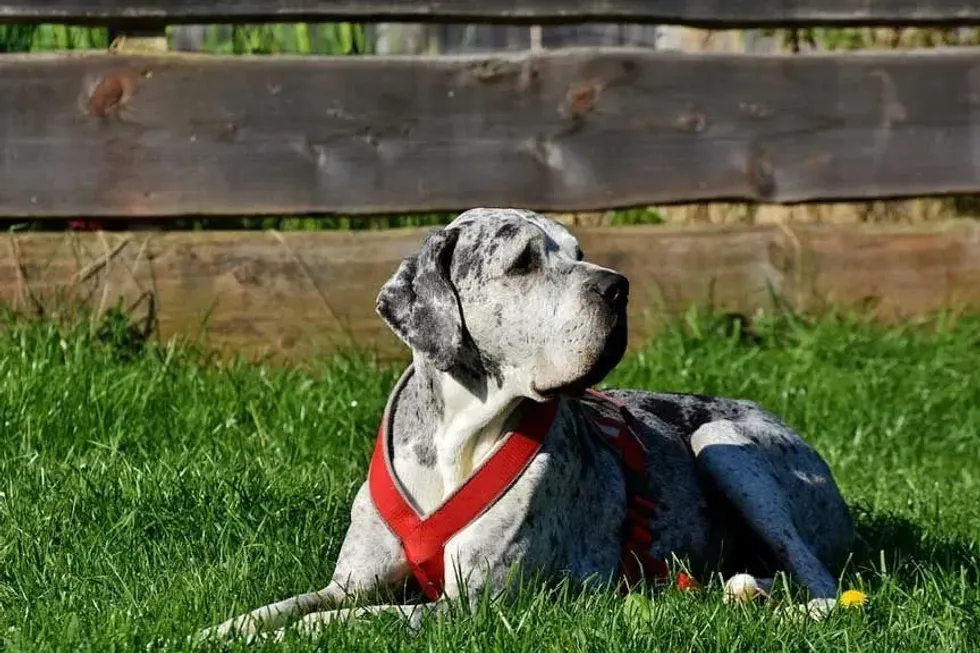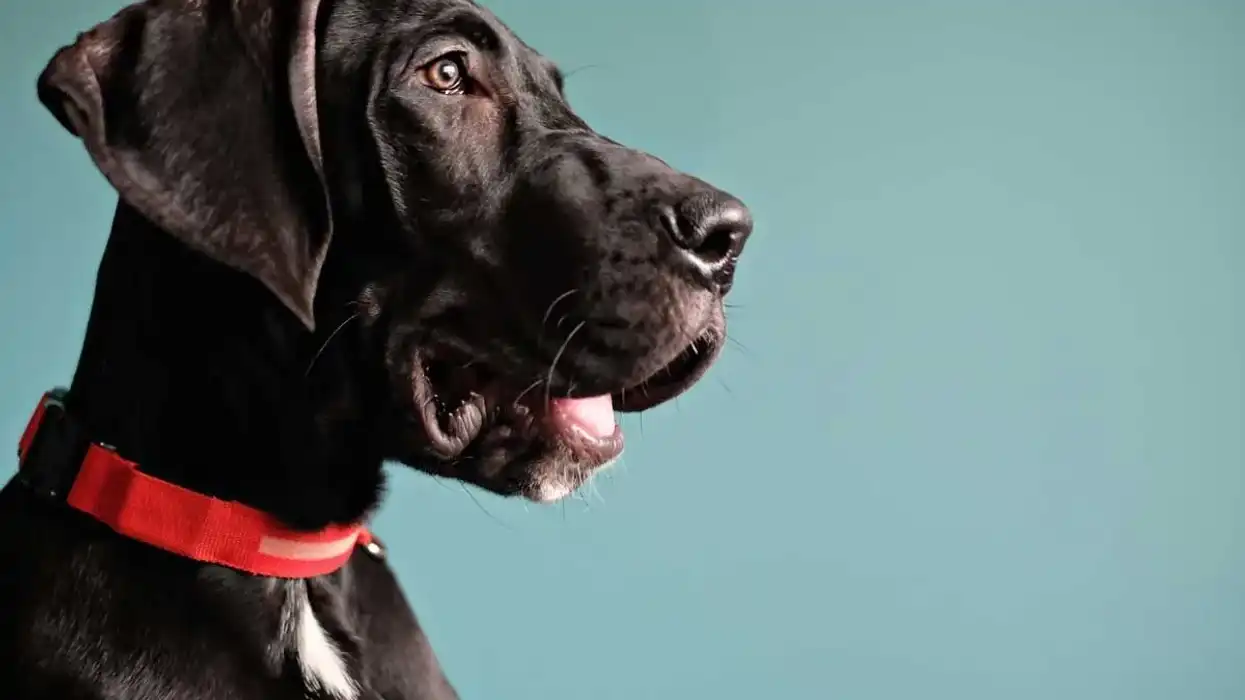Fun Great Dane Facts For Kids

It is very unlikely for any person to not have at least once in their lives, seen or heard of the great dane breed of dogs. Known for their graceful bearing, noble gait, and towering structure, the great danes are nicknamed as gentle giants.
These gentle giants originated and were bred in Germany since the 17th century.
Great danes, also known as the Apollo of dogs, were used by the nobility while hunting bears, boars, and deers.
The Germans imported Greek breeds like the Molossian hound (known to be one of the fiercest breeds of dogs in the ancient world) to improve the next generation of these dogs.
In 1878, these dogs, which were originally called Englische dogge by the Germans due to the original dogs used for breeding being imported from England, were given the name Deutsche dogge.
Being a hunting dog breed, great danes require proper exercise and diet for good health. In the 19th century, they were finally called German boarhounds and with time picked up the name great dane.
This breed has been recognized by the American Kennel Club and the great dane was the fourth breed that was allowed to join the American Kennel Club.
After going through great dane information and facts, you may also look at American leopard hound facts and Bavarian mountain hound facts.
Great Dane Interesting Facts
What type of animal is a great dane?
A great dane is a breed of dog belonging to the canine family. Great danes are believed to be a cross between mastiffs, Irish wolfhounds, and greyhounds.
Great danes contain distinctive characteristics from each of these breeds. They owe their strength and muscle mass to mastiffs, speed to greyhounds, and height to wolfhounds. In and after the 18th century, they were bred to be less aggressive in nature and more domestic.
Now great danes are protective companion dogs who have earned the title of gentle giants for their sweet temperament. They are currently the holder of the title of the world’s tallest dogs.
What class of animal does a great dane belong to?
Great danes are bred through conception and development in their mother’s womb. They have the ability to give birth, which puts them in the class of Mammalia. Great dane rescue instincts make them a great rescue and hunting dog that were originally used for hunting boar and other wild animals.
How many great danes are there in the world?
Unspecified. There isn’t sufficient research done to know the exact number of great danes in the world. However, harlequin great danes were declared as the 14th most desirable breed in the USA in 2017.
Where does a great dane live?
Great danes have short and smooth skin. They do not have the coat or fur characteristic similar to a lot of other breeds.
They also do not contain a thick coat of fat in their bodies, and this puts them in a highly sensitive position temperature-wise. Savannas are thought to be really good for them, with care taken during cold and extreme weather. They can adapt to a lot of places in the world if taken proper care of.
What is a great dane's habitat?
Great danes, with their social and loving nature, can live almost anywhere their loved ones go. However, it is advised for a house or apartment to have plenty of space so that the dane can stretch and move around. Considering their heights of 28-33 in (71-83 cm) and taller, this is important to remember along with training them carefully.
Who do great danes live with?
Great danes are very friendly dogs. They are one of the favorites among humans who are looking to adopt these dogs.
They can be found living with almost all sizes of families. Many families often get multiple great danes in a pack, but they do well with other breeds of dogs and other species of pets as well.
They do well around children but are advised to be trained properly so as to not be aggressive towards strangers or develop any undesirable habit.
How long does a great dane live?
Great danes, unfortunately, live for an average of six to 10 years. Some, of course, have proven to survive longer under good care. But, it seems these joyful cuddle bugs leave too soon owing to their huge size.
How do they reproduce?
Their heat cycles begin after six to 12 months of their life, and they are best bred between the ages of two to seven years. They require more care during this stage.
They reproduce like most dogs do; through the male mounting and making a connection with the female. Their pregnancy lasts 63 days on average but this can vary a lot. It can also take time to detect their pregnancies.
The average litter size is eight, but larger litters have been seen. The largest till now has been 21 puppies in one litter delivered naturally.
What is their conservation status?
The great dane conservation status is currently not listed, which may mean that these breeds are doing well and are good in numbers. The only concern is regarding their health and diet, which if taken care of will ensure their longevity.
Great Dane Fun Facts
What do great danes look like?
These dogs are a cross between some of the greater dogs like mastiffs and greyhounds. They possess certain distinctive characteristics from their parent breeds, like strength and size. They are very large-sized breeds and require a good amount of training and care. Their coat colors range between fawn and brindle fawn.

How cute are they?
Great danes may not be fluffy and small enough to be carried around like lap dogs, but they are one of the favorites amongst the masses for a reason. They are, despite their size, one of the calmest dogs which are known to follow their owners around seeking attention.
As mentioned above, they are very affectionate, cuddly, and protective while maintaining to be social. Every dog is, of course, unique but the great danes will let you know they love you every moment.
How do they communicate?
These dogs, even though calm, have one of the deepest growls and barks. If their sheer size is not sufficient to drive away intruders, then their bark will do. Dogs of this breed have been noticed to sit on owner’s laps far after their puppy years, whine, playfully nudge and lean on loved ones looking for affection.
How big is a great dane?
Great dane's average height is 35-43 in (88-109 cm). A fully grown specimen of this breed, when standing on two toes, can be equivalent to or taller than most humans.
When compared with chihuahuas, it can be said that great danes are ten to 15 times their size. The great dane named Zeus holds the current guinness world record for being the tallest dog with a height of 44 in (111 cm).
How fast can a great dane run?
Great danes can be really fast, with their average speed reaching up to 30 mph (48.2 kmph). Their big size allows them to run at a faster pace.
How much does a great dane weigh?
Great danes weigh around 100-180 lb (45-81 kg). Being athletic, dogs of this breed require ample exercise daily.
What are the male and female names of the species?
Great danes are a dog breed with the scientific name Canis lupus familiaris. A male of the species is called a dog while a female is called a bitch.
What would you call a baby great dane?
Like with all breeds of dogs, a baby great dane is called a puppy.
What do they eat?
All dogs are known to be direct descendants of wolves, with variations turning up to shake the gene pool a bit here and there. The various breeds are also formed in accordance with the climate of the region.
However, the great dane, like most dogs, are omnivores. Dogs of this breed can be fed both meats and vegetables with a bit more emphasis on whole proteins.
Are they slobbery?
Yes. They have a wide muzzle. Great danes can be quite slobbery. Owners are advised to carry a handkerchief around them to clean when necessary.
Would they make a good pet?
Yes, dogs of this gentle breed would make adorable pets. These danes like to be around people and love to spend quality time with them.
However, these dogs come with great responsibility as well as they need proper care, training, and an adequate amount of food. As this breed is at the risk of bloat, any form of extreme exercise should be avoided during mealtimes.
You must ensure that you purchase or adopt the puppy from registered breeders only to avoid any hassles later on.
They make lovely family dogs as they get along with children and other animals. However, they also bark a lot so if you prefer a quite animal, these are not the dogs for you.
Did you know...
Great danes differ not only by breed but also by region. They were originally bred from mastiff dogs. The behavior of American and European great danes has been observed to be different. American danes are sleeker in structure than European ones, who are bigger in size.
American great danes have also been observed to be lighter than their European counterparts. European great danes have slightly bigger, squarer heads, droopier eyes, and bigger lips. Their American counterparts have more rectangular heads with higher streaks.
Due to their vulnerability to congenital heart diseases, great danes are sometimes called the heartbreak breed. Traditionally, these dogs were used for hunting of boar and other wild animals.
What are great danes known for?
Apart from their giant status, great danes are known for their history. Dogs of this breed were bred for high-class German masses to be taken as a company during hunting and for protection.
This dog breed was loved enough to have lasted for more than 400 years. The breed currently seen is thought to have been bred around the 1800s. They were widely used for the hunting of boars and other wild animals.
They have had many different names but the name great dane is supposed to be picked up from a person remarking 'grand danois' (french for great dane) when seeing one of these dogs, despite the breed being German. 'Apollo of dogs' is another one of their nicknames and is speculated to be given due to their majestic appearance.
In 1876, great danes were declared as the National Dog of Germany.
Having your own great dane
Great danes were originally hunters. They have been bred and have evolved through time to have the nature that they have today.
Perhaps, that explains why people are still unsure of leaving their children alone with great danes, and the American Kennel Club advises adults to accompany children when with these dogs. However, they make one of the most endearing pets.
Great danes, being the giant dogs that they are, require around 30 to 40 minutes of exercise every day. Owners are asked to wait till the puppies are at least 18 months, if not two years of age, before putting them on an exercise schedule.
They can be sensitive and aggressive towards strangers or other dogs if untrained or not given enough attention. They don’t shed massively which means they do not require as much grooming.
But they are known to be flatulent and have bigger appetites. But as they are at risk of bloat, you must not engage them in heavy exercise around meal times.
Great danes go very well with children or other pets they have grown with. They are very prone to be affected with health troubles as they grow older.
These include heart diseases, bone disorders such as dysplasia and arthritis, cancers like lymphoma and osteosarcoma. But a fatal health problem that has led many great danes to their deaths is GDV or bloating.
It is a digestive problem that is common among bigger breeds. These problems can be tackled or delayed with proper care, scheduled meal times with three small meals a day, and regular visits to the vet.
If trained properly, a great dane puppy can truly be the majestic and caring dog they are thought to be. However, it is worth it to note that one should not assume the personality of a pet.
Many domesticated animals, including great danes, are known to have been abandoned by their owners at shelters. They are to be loved responsibly and given the promised care.
Here at Kidadl, we have carefully created lots of interesting family-friendly animal facts for everyone to discover! Learn more about some other mammals including hokkaido dog, or shepherd collie mix.
You can even occupy yourself at home by drawing one of our Great dane coloring pages.
We Want Your Photos!
More for You
Sources
https://www.akc.org/dog-breeds/great-dane/
https://dogtime.com/dog-breeds/great-dane
https://en.wikipedia.org/wiki/Great_Dane
See All
Bachelor of Arts specializing in Linguistics

Martha MartinsBachelor of Arts specializing in Linguistics
Martha is a full-time creative writer, content strategist, and aspiring screenwriter who communicates complex thoughts and ideas effectively. She has completed her Bachelor's in Linguistics from Nasarawa State University. As an enthusiast of public relations and communication, Martha is well-prepared to substantially impact your organization as your next content writer and strategist. Her dedication to her craft and commitment to delivering high-quality work enables her to create compelling content that resonates with audiences.
Bachelor of Science specializing in Computer Science

Chandan ShuklaBachelor of Science specializing in Computer Science
With a Bachelor's degree in Computer Science from Aryabhatta College, University of Delhi, Chandan is a skilled and passionate technophile. He has completed a machine learning training program and is adept in various programming languages. He has been working as a content writer for two years while also striving to become a proficient tech professional.
Disclaimer
1) Kidadl is independent and to make our service free to you the reader we are supported by advertising. We hope you love our recommendations for products and services! What we suggest is selected independently by the Kidadl team. If you purchase using the Buy Now button we may earn a small commission. This does not influence our choices. Prices are correct and items are available at the time the article was published but we cannot guarantee that on the time of reading. Please note that Kidadl is a participant in the Amazon Services LLC Associates Program, an affiliate advertising program designed to provide a means for sites to earn advertising fees by advertising and linking to Amazon. We also link to other websites, but are not responsible for their content.
2) At Kidadl, we strive to recommend the very best activities and events. We will always aim to give you accurate information at the date of publication - however, information does change, so it’s important you do your own research, double-check and make the decision that is right for your family. We recognise that not all activities and ideas are appropriate for all children and families or in all circumstances. Our recommended activities are based on age but these are a guide. We recommend that these ideas are used as inspiration, that ideas are undertaken with appropriate adult supervision, and that each adult uses their own discretion and knowledge of their children to consider the safety and suitability. Kidadl cannot accept liability for the execution of these ideas, and parental supervision is advised at all times, as safety is paramount. Anyone using the information provided by Kidadl does so at their own risk and we can not accept liability if things go wrong.
3) Because we are an educational resource, we have quotes and facts about a range of historical and modern figures. We do not endorse the actions of or rhetoric of all the people included in these collections, but we think they are important for growing minds to learn about under the guidance of parents or guardians.







